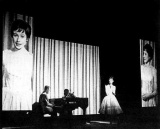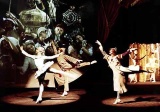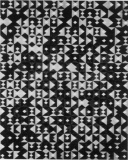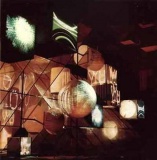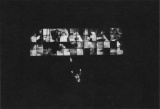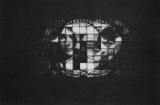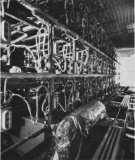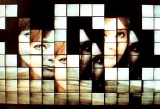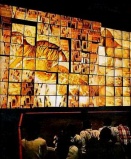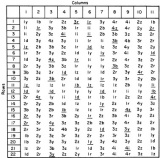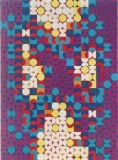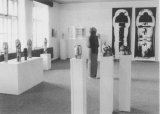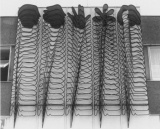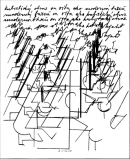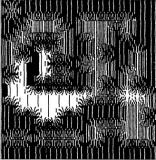Arts and engineering groups and collectives in CEE
Contents
Exat 51[edit]
- 1950-56, Zagreb. The group was formed at the plenary meeting of the Association of Applied Artists of Croatia, at which they proclaimed their manifesto: to protest against the dominance of officially sanctioned Socialist Realism and the condemnation of all forms of abstraction and motifs unacceptable in Communist doctrine as decadent and bourgeois. Exat-51 emphasized that such an attitude contradicted the principles of Socialist development, that the differences between so-called 'pure' art and 'applied' art were non-existent and that abstract art could enrich the field of visual communication. The activity of the group was therefore to spring from the existing social situation and, as such, to contribute to the progress of society. The principal intention was to attain a synthesis of all branches of the fine arts and to encourage artistic experimentation.
- Its members were the architects Bernardo Bernardi (1912-85), Zdravko Bregovac (b 1924), Zvonimir Radić (1921-83), Bozidar Rašica (1912-92), Vjenceslav Richter (b 1917) and Vladimir Zarahović, and the painters Vlado Kristl (b 1922), Ivan Picelj (b 1924) and Aleksandar Srnec (b 1924).
- Works. Examples of works = ??. First exhibition: at the Hall of the Architects' Society of Croatia (Zagreb, 1953).
- International context. Many similar tendencies and artistic attempts were happening in Europe. One can mention here just slightly earlier movements in Italy, such as Forma Uno (Rome, 1947), Movimento arte concreta (Milan, 1948), Arte d'oggy (Florence 1950), with whom the members of Exat 51 had no contact whatsoever. More direct parallels might be drawn between group Espace, formed in 1951 that under intellectual guidance of Le Corbusier promoted the idea of synthesis of arts, but Exat 51 came to know its activity only in 1952 when they exhibited at Salon des Realites Nouvelles in Paris, manifestation that promoted abstract art.
- Available publications. Catalogue edited by Marijan Susovski was published in 2001, PDF = ?? [1]
New Tendencies[edit]
- 1961-73, Zagreb.
- Members. Started by a group of Zagreb-based experimentators, Vjenceslav Richter, Ivan Picelj, Julije Knifer, Aleksandar Srnec, and others who founded Exat 51 group.
- Works. In the beginning, the movement characterized broad issues but later the exhibitions veered towards neo-constructivism, lumino-kinetic objects (mostly mechanically made, often under group authorship) and finally computer art and conceptual art. Organised the series of five international exhibitions and nine symposia in Gallery for Contemporary Art, Zagreb. The first exhibition (1961) contained works that were bent mostly on a system research and optical research of the surface and the structure of objects. The demands for the scientification of art favored experimenting with new technical media as a means of researching the visual perception based on the Gestalt theory. The third exhibition (1965) probed the relationship between cybernetics and art. In 1968 the movement decided to incorporate into its program the computer as a medium of artistic work, and the fourth exhibition (1968/69) was dominated by the information theory. The same year, the Gallery of Contemporary Art started the Bit international magazine. Conceptual art and computer art were prominently marked on the Tendencies 5 exhibition poster (1973).
- Regime. Their research was state sponsored.
- Available publications. Mostly unpreserved objects and texts of the group were extensively researched by Darko Fritz, who organised large-scale retrospective exhibitions in Zagreb (2000) and ZKM (2008-09). Matko Mestrovic was the main theorist of New Tendencies as a movement who tackled the problem of the relationship between art and society demanding the socialization of arts, abolishing the unique significance of a work of art and equaling art and science. Catalogue edited by Marijan Susovski was published in 2001, PDF = ?? [2]. ZKM exhibition catalog will be published in spring 2009 (The anthology includes texts from the 'Neue Tendenzen' – catalogs and also from the magazine 'bit international' from 1961–1973. It also will inlcude texts and documents from the archive of the MSU Museum of contemporary Art Zagreb).
Open Form[edit]
- 1950s-70s, Warsaw. Concept developed by the architect Oskar Hansen and developed further in the direction of film and performance by his students at Warsaw Academy of Fine Arts. The 'open form' originated in the 1950s as a response to the ossified design principles of modernism and was intensively discussed within the frame of international debates on the architecture of late modernism (for example, in Team 10). In the 1960s and 70s, against the background of socialist Poland, young artists created innovative filmic works and performative interventions that give rise to interplays rich in associations between image space and real space.
- Members. Professor Grzegorz Kowalski, Hansen's former student, developed his teaching ideas in a creative way, confronting students with tasks that went beyond the traditional requirements of "sculptural skills".
- Works. "Didactics of process instead of didactics of the object" was the ruling principle of the group, rooted in the premises of an open form program formulated in the late 1950s by architect and urban designer, Oskar Hansen, the author of a famous (unrealized) plan for a monument dedicated to the memory of Auschwitz conceived as a road cutting the space of the camp diagonally. Hansen raised several generations of Polish sculptors, which he tought about the space as both dynamically and socially conditioned. His work inspired artists such as: Grzegorz Kowalski, Krzysztof Bednarski, Zofia Kulik, Przemyslaw Kwiek, and indirectly also a lot of younger artists: Katarzyna Kozyra, Pawel Althamer or Artur Zmijewski. Second place, outside the Warsaw Academy of Fine Arts, where students can see the theory of Open Form is a Norwegian BAS (Bergen School of Architecture). The university was founded in 1983 by Hansen's student - Svein Hatloy.
- The film Open Form was carried out jointly by the students of Lodz Film School and the Department of Sculpture of the Warsaw Academy of Fine Arts in 1971.
- International context. ??
- Available publications.
- Lukasz Ronduda writes about Zofia Kulik's scenes in Open form film (1971) [6]
- Extensive article about Oskar Hansen (Polish) [7]
- Oskar Hansen, "Towards Open Form / Ku Formie Otwartej". Frankfurt am Main: Revolver, 2005. Paperback 256 pages / ISBN 83-89302-07-1. reviews: [2], [3]. The non-textual introduction is an iteration from the Polish catalogue for the 1960 Milan Triennal. 'Bridging' the book's two parts are interviews with the artist: Joanna Mytkowska's in the first part (conducted in spring 2003), and fragments of Hans Ulrich Obrist's in the second. Oskar Hansen died on May 11, 2005, after work on this book had been completed and it had been sent to press. The book has been left unchanged.'
Dvizheniye[edit]
- 1962-1974, Moscow. In 1962, a group of young artists, primarily students at the art school affiliated with the Surikov Institue in Moscow, made their first attempts to unite on the basis of their common interests in art.
- Members. Lev Nusberg, Galja Bitt, Sascha Grigorjev, Francisco Infante, Tatjana Bystrova.
- Works. The group was active on both an artistic and a theoretical level (producing manifestos, scripts and articles as well as artworks). Followed three principles: movement, synthesis, symmetry. Activities ranged from early, static works in painting and sculpture to large-scale kinetic constructions, performance, installations and projects related to urban planning. Projects: "Cross" (1963), "Programmed Picture" (1963), "Soul of Crystal" (1964), "Space-Movement-Infinity" (1963-64), "The Flower" (1965), "The Square of Nine Muses" (1965), "Galaxy" (1967), "Cyberevents" (1967), "Artificial Bio-Kinetic Media" (1969). Exhibitions: "Towards a Synthesis of the Arts" (Moscow, 1964); "Performance of Kinetic Art" (Leningrad, 1965).
- International context. ??
- Available publications.
- Vyacheslav F. Koleychuk, The Dvizheniye Group: Toward a Synthetic Kinetic Art, Leonardo, Vol. 27, No. 5, Prometheus: Art, Science and Technology in the Former Soviet Union: Special Issue (1994), pp. 433-436 [8]
- Lev Nusberg, "Cybertheater", Leonardo, Vol. 2, pp. 61-62 (1969)
- "Russian 'Movement' Group" (From "CMeHa", No. 1, January, 1968), Leonardo, Vol. 1, No. 3 (Jul., 1968), pp. 319, [9]
- The group wrote the "Manifesto of the Russian Kineticists" while preparing for the 1966 exhibition.
ARGO[edit]
- 1970-1975?, Moscow. (abbr for Author Working Group)
- Members. Formed by Francisco Infante, Nonna Goriunova (his wife) and Valerii Osipov "as a force capable of realizing projects for articially created spaces".
- Works. Realised eight projects.
- The Galactic (1967) installation and the project to provide kinetic lighting for the monuments in Red Square and the castle at Odesko were an attempt to make technology "sound" with the power of art, to proclaim the new beauty of such a sound.
- In Sound and Color (1970), Construction Materials '71 (1971), and the Togliatti project (1973), we wanted to come nearer to the possibility of an artistic synthesis, which we un- derstood as a fusion of varied artistic forms with new technological methods.
- Crystal (1971), Luminescence (1973), and Needle (1975) were based on ideas of fantasy. They were inspired by futuristic concepts of human existence in outer space.
- The space exhibition Unispace in Vienna (1982) was a dynamic area created by the mysterious simplicity of mirror reflections
- International context. "Since the group had no resources of its own, our ideas were, for the most part, embodied in exhibition installations sponsored by various firms, combines and institutes."
- Available publications.
- Extensive descriptions of ARGO's projects, along with illustrations: Francisco Infante, "Artificially Created Spaces: The Projects and Realizations of the ARGO Group" The Journal of Decorative and Propaganda Arts, Vol. 5, Russian/Soviet Theme Issue (Summer, 1987), pp. 112-125 [10]
- Francisco Infante, "Projects for the Reconstruction of the Firmament" Leonardo, Vol. 25, No. 1 (1992), p. 11 [11]
Kinema Ikon[edit]
- Arad 1970-2005
- Members.
- Works.
- International context.
- Available publications.
Theremin Center[edit]
- Moscow *1992
- Members: Andrei Smirnov. Composers, musicians and artists, attending classes or working at the Theremin Center in 1992-1998, [12]
- Works.
- International context.
- Available publications.
more[edit]
Macedonia[edit]
- Denes, *1953. Based on the concept of the ‘synthesis of arts’ this group established a specific role of the art: to incorporate several art-disciplines (painting, sculpture, and graphic print) with the architecture.
Hungary[edit]
- Balázs Béla Studio in Budapest, *1961
- Budapest New Music Studio, founded in 1970 by László Vidovszky, Zoltán Jeney, László Sáry, Péter Eötvös, and Albert Simon. Active throughout 1970s and 80s.
- Indigo, founded by Miklós Erdély, 1970s-80s. Musicians, sculptors and experimental film-makers
- K/3 experimental film group established in Balász Béla Studio in 1976. Members included Gábor Bódy.
Soviet Union, Russia[edit]
- Dvizheniye, 1962-74, Moscow (see above)
- ARGO, 1970-75?, Moscow (see above)
- Prometei, *1962, Kazan. founded by Bulat Galeyev
- Theremin Center, *1992, Moscow (see above)
Czechoslovakia[edit]
- Zdeněk Sýkora with Jaroslav Blažek, Prague, since 1966, first computer generated line paintings in 1972
- Jozef Jankovič with Imrich Bertók, Bratislava, since 1966/1973, lithographies and serigraphies based on computer-generated drawings
- Jaroslav Frič with Josef Svoboda (Polyvision, 1967); Jaroslav Frič with Radúz Činčera (Kinoautomat, 1968)
- composer and theorist Alois Piňos with graphic artist Dalibor Chatrný, created four audiovisual compositions in 1969-71: Statická kompozice (for electronic music and slides, 1969), Mříže (for piano and film, 1969), Geneze (for chamber ensemble and film, 1970), Adoration (composition utilizing pendent plastic objects made to ring in different ways, 1970).
- Milan Grygar with musical theorist Vladimír Lébl, exhibition for the festival of experimental music in Smolenice, 1970
- Petr Kotík with Jan Kučera, at Buffalo University, 1971-1983
- Juraj Bartusz with Vladimír Haltenberger, Bratislava, since 1973, manufactured sculptures based on computer-generated curves
- Daniel Fischer with computer engineers Pavol Fischer and Igor Klačanský, Bratislava, since 1975, computer morphing line drawings
- Milan Guštar has been providing technical support for the works by David Černý, Silver, Federico Díaz, Miloš Vojtěchovský, Michael Bielický and others since 1987.
- Transmusic comp. group, 1989-1996.
- Silver, *1994, Petr Svárovský, Milan Guštar and Pavel Rejholec.
Slovenia[edit]
- avant-garde group OHO in Ljubljana, 1960s and early 1970s. used drawings, photographs, film, video, music, texts, also the way of dressing, living and behaviour.
- Laibach
Croatia[edit]
- Exat 51, 1950-56, Zagreb (see above)
- New Tendencies, 1961-73, Zagreb (see above)
- Free experiments with mixed media were part and parcel of the poetry of the so-called Group of Six Artists who mixed media such as photography, film, and photocopy in the form of visual art, art books and (street) performance. Active in Croatia.
- Vladimir Petek set up in 1971 the FAVIT art association (film-audiovisual research - television) and created a series of multimedia works with a number of collaborators, mostly multivision (multi-channel video, film and slide projections), and realized ten computer movies with Tomislav Mikulic in 1976.
- In the late 1980s in Croatia, the Nova Evropa (NEP, founded by Dejan Krsic) group, Studio imitacija zivota (SIZ; Darko Fritz and Zeljko Serdarevic), Grainer and Kropilak and the Katedrala project displayed artistic activity carried out under a collective authorship (in the Katedrala project a computer programmer has been included as a full-fledged author). The above-mentioned used the media as their basic material (reproductive, electronic, digital and mass media) and inaugurated sampling/cut-up/quotation/recycling as an expression without specific stylistic characteristics, i.e. the rejection of the idea about the original. The medium of photocopy in the pre-Photoshop aesthetics of the 1980s (in the wake of experiences of copy art of the 1970s) was the prime graphic tool. In the case of SIZ and NEP more indicative were their media projects than the produced objects. NEP inaugurated a new understanding of equaling politics and art, not just by ³borrowing² from political rhetoric but also by using it on an equal footing, in the spirit of post-modernist theories. In 1988, SIZ thrice opened an exhibition (of graphics) using three manners of opening: live broadcast over the radio, by a spoken word of an art historian, and by textual print-outs of interviews. In 1990, SIZ stopped working after having completed a three-year production and distribution (corporative) plan. The Katedrala project (Bakal, Fritz, Juzbasic, Marusic, Premec; 1988) took place on the anniversary of death of Andy Warhol and called for a transformation of image to sound of a Mussorgsky composition and the sound into a space performance of Kandinsky. It was a space generated by a computer using joint sound, light, and video elements set in motion through the movement of the audience and the signals of an EEC connected to the performer, Joska Lesaj, the opera signer.
Romania[edit]
- 111, 1966-1969, Timisoara. Neo-constructivist group. Roman Cotoşman, Ştefan Bertalan, Constantin Flondor.
- Sigma, 1970-1978, Timisoara.
- Kinema Ikon, 1970-2005, Arad. Structuralist-borne implant in experimental film-making. (see above)
- SubREAL, *1990, Bucharest
Bosnia and Herzegovina[edit]
- Sarajevo New Primitives, *1982, Sarajevo
Poland[edit]
- Open Form 1950s-70s (see above)
- Zero-61, 1961-69, Lodz. Members included Jozef Robakowski, Czesław Kuchta, Jerzy Wardak, Andrzej Różycki, Antoni Mikołajczyk, Wojciech Bruszewski.
- Workshop of Film Form, 1970-77, Lodz. Founded within the framework of the Student Science Club of the National Film School in Lodz. The Workshop's practice, focuses on an analysis of the new media language (photography, film, video), drew its inspirations from the constructivist tradition and conceptualism, striving to get film rid of 'alien elements' (anecdote, literary forms, narration), make its language simpler and information denser. Members included Jozef Robakowski, Wojciech Bruszewski, Antoni Mikołajczyk, Wasko.
- Yach-Film group, *late 1980s. Worked on the border of film and video. Members included Yach Paszkiewicz, Dorota Podlaska, Bombela Kuich, Andrzej Kuich, Andrzej Wasik.
Works[edit]
Josef Svoboda, Laterna magika, 1958
Josef Svoboda, Laterna magika, 1958
Josef Svoboda, Laterna magika, 1958
Josef Svoboda, Jaroslav Frič, Polyvision, 1967. © Josef Svoboda, Jaroslav Frič
Josef Svoboda, Diapolyecran at the Czech Pavilion at Expo 67. Each square is a self-contained automatic slide-projector unit. Through careful programming the images appear either isolated or unified.
Josef Svoboda. A fractured image on the Diapolyecran. The image can move as in film (through the extremely rapid changing of slides) or appear static in any kind of mosaic formation.
Josef Svoboda. The slide-projector equipment bank of the Diapolyecran. Each of 112 projectors was mounted on its own carriage which could take position in one of three places. The slide image and movement program was memorized on tape and controlled from a central booth not pictured.
Josef Svoboda, Polyecran, 1967
Josef Svoboda, Polyecran, 1967
Radúz Činčera, Kinoautomat One Man and his Jury, 1967
Radúz Činčera, Kinoautomat, 1967
Radúz Činčera, Kinoautomat, 1967
Jozef Jankovič, exterior design for a general hospital in Bratislava IV, colored aluminium and epoxy, 6 x 6 m, 1981-1982. The artwork was created according to computer drawings using the PDP11 computer and the Calcomp plotter. Each column shows the morphing of an outline of part of the human body into an electrocardiograph signal.

